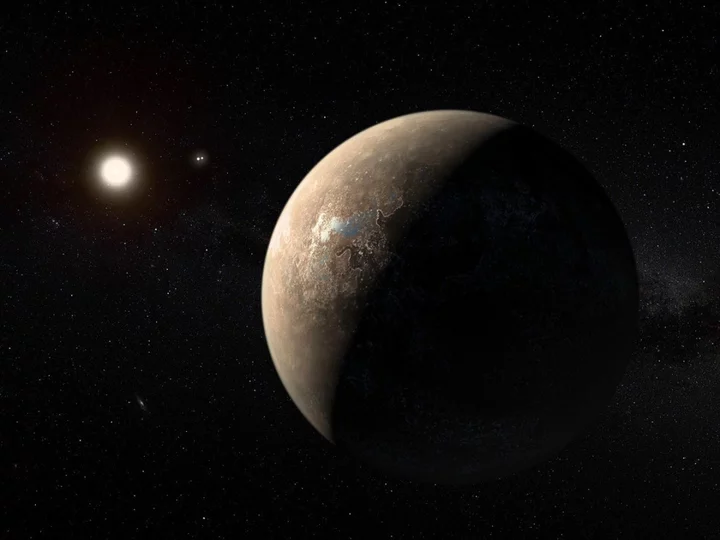
Geminids meteor shower began life in a ‘violent catastrophe’, scientists say
The Geminids meteor shower began in a “violent catastrophe”, scientists have found. Every winter, the world is delighted by the meteor shower, which brings some of the most intense display of ‘shooting stars’. But that spectacle has been rivalled by its mystery. The Geminids are unusual in that most meteor showers are created when a comet leaves behind a tail of ice and dust – but the Geminids come from an asteroid, which do not usually leave behind a tail. Asteroids are chunks of rock and metal flying around in space. The Geminids appear to originate with one called 3200 Phaethon, which for an unexplained reason is affected by the Sun and leaves behind a stream across the night sky. “What’s really weird is that we know that 3200 Phaethon is an asteroid, but as it flies by the Sun, it seems to have some kind of temperature-driven activity,” said Jamey Szalay, research scholar at the Princeton University space physics laboratory and co-author on the paper. “Most asteroids don’t do that.” Attempts to solve that mystery have struggled in part because the meteor shower has only been observed from Earth. Now, however, researchers using Nasa’s Parker Solar Probe have been better able to examine the the Geminids. They suggest that a violent, catastrophic event gave rise to the meteor shower. That could have been a high-speed collision with another object in space, for instance, or a gaseous explosion. Some researchers have previously suggested that 3200 Phaethon might really be a comet, and that it lost its snow to leave behind just a rocky core that looks like an asteroid. But the new study makes clear that the origins of the meteor shower are much more dramatic than that. In an attempt to understand the meteor shower, researchers simulated three possible formation scenarios and then compared them with models based on observations from the Parker Solar Probe. That included a less violent scenario, a more violent one, and another that was in line with a comet. When they compared those scenarios with the actual observations, they found that the violent one was the most similar. That suggests that it was the result a collision or similar dramatic event. Researchers still do not know for sure what happened. But the new study helps narrow down the possibilities – as well as shedding more light on such events in space. The findings are published in a new article, ‘Formation, Structure, and Detectability of the Geminids Meteoroid Stream’, published in Planetary Science. Read More Watch live as astronauts step out of ISS for latest spacewalk Major finding boosts hope for finding alien life in our solar system Astronomers find rare planet circling two stars like Star Wars’s Tatooine
2023-06-15 23:54

Major finding on Saturn’s moon Enceladus boosts hope for finding alien life in our solar system
Phosphates have been found on Saturn’s moon Enceladus, in a new breakthrough discovery that boosts hopes for finding alien life in our solar system. It is the first time phosphorus has been found in an ocean beyond those on Earth, and marks a major development in our understanding of other ocean worlds. Enceladus is one of the most likely hopes for finding nearby extraterrestrial life. While its outside is wrapped in an ice crust, underneath is a global ocean that could be a home for alien life. Some of that ocean spews up and out of the surface of Enceladus, in the form of vast plumes. Scientists have been able to examine those plumes to better understand the ocean itself, including in the new study. Researchers in the latest study used data from the Cassini mission – which flew around Saturn and Enceladus – to find out what the oceans are made up of. They not only found phosphorus, but data suggested that it could be there are concentrations at least 100 times higher than in Earth’s oceans. What’s more, modelling based on the new data suggests the same could be true for other ocean worlds, potentially boosting the chances of alien life there, too. Phosphorus is not in itself evidence of life. But on Earth, the presence of phosphorus compounds in water are crucial for biological activity, and so it is a key part of evaluating whether a distant world might support life. Read More Astronomers find rare planet circling two stars like Star Wars’s Tatooine Elon Musk to launch biggest ever rocket after dramatic failure US government contradicts whistleblower’s claims of possible ‘non-human’ material
2023-06-14 23:21

Elon Musk to launch biggest ever rocket after dramatic failure
SpaceX will attempt to launch its Mars-bound Starship rocket within the next eight weeks, Elon Musk has announced. It will be the second time SpaceX has attempted an orbital launch of its Starship system, which is the biggest and most powerful rocket ever developed. The first attempt at an orbital Starship launch took place in April, ending in a dramatic explosion just minutes after lift-off. Responding to a request on Twitter for an update on Starship, Mr Musk said the next test would be in “6 to 8 weeks”. The SpaceX boss has previously said that he hopes to build an entire fleet of Starship rockets in order to transport people and cargo across the Solar System. The private space company has already signed a mult-billion dollar deal with Nasa to use Starship for its Artemis programme, which aims to return humans to the Moon within the next few years. The launch site for the next orbital flight test will be from SpaceX’s Starship facility in Texas. If successful, the rocket will then complete a 90 minute journey around the Earth before touching down off the coast of Hawaii. No crew will be aboard the stainless steel Starship, which stands 120 metres tall and is capable of 16.7 million pounds of thrust – twice the power of the Saturn V rocket that took humans to the Moon. The size of the rocket, which has two main stages, means it is powerful enough to lift up to 250 tons into orbit, or carry 100 people on a trip to Mars. Read More Elon Musk eyes ‘highly habitable’ planet that’s ‘practically next door’
2023-06-13 23:24

Jury finds Berkshire's PacifiCorp unit liable in 2020 Oregon wildfires
By Jonathan Stempel An Oregon jury on Monday found the utility PacifiCorp, a unit of Warren Buffett's Berkshire
2023-06-13 03:49

Elon Musk eyes ‘highly habitable’ planet that’s ‘practically next door’
A study detailing the habitability of a nearby exoplanet appears to have caught the attention of SpaceX boss Elon Musk. The tech billionaire has frequently spoken of his intention to transform humanity into a mult-planetary species through his private space firm, with plans to colonise Mars within the next few decades. The study of Proxima Centauri b, which sits within the so-called ‘Goldilocks Zone’ of the red-dwarf star Proxima Centauri, involved computer simulations to evaluate whether it can sustain liquid water that may harbour living organisms. “The major message from our simulations is that there’s a decent chance that the planet would be habitable,” Anthony Del Genio, a planetary scientist at the Nasa Goddard Institute for Space Studies said when the study was first published in 2018. The study concluded that Earth-sized planet is potentially the closest “highly habitable” planet to our Solar System, located 4.2 light-years away from the Sun. “Practically next door,” Mr Musk wrote in a tweet on Sunday, sharing the study. Proxima Centauri b has been the subject of several studies since it was first discovered in 2016, with astronomers attempting to assess whether it is capable of sustaining life. Similar to the Earth’s moon, the planet is “locked” due to gravitational forces, meaning that the same side of Proxima Centauri b always faces its parent star. Computational models suggest that the exoplanet’s circulating oceans and atmosphere act as an effective transfer of heat, so that its dark side is not permanently frozen. Despite its relatively close distance compared to other potentially habitable planets, travelling 4.2 light-years – or 40 trillion kilometres (25 trillion miles) – requires technology that is still in the conceptual stages of development. Nasa’s interstellar space probe Voyager 1, which was launched in 1977, would take 80,000 years to travel to Proxima Centauri, however the US space agency’s DEEP-IN programme aims to make the journey possible within a single lifetime. Scientists working on DEEP-IN claim that small crafts propelled by light could travel at speeds of up to 161 million kilometres per hour, and could reach the neighbouring star and exoplanet in 20 years. Mr Musk has frequently voiced his concerns about humanity’s long-term survival, claiming that setting up self-sustaining colonies on other planets is vital to ensure the continuation of our species. SpaceX has so far been at the forefront of these endeavours, developing its reusable Starship rocket with the intention of transporting people and cargo across the solar system. Read More Elon Musk refuses to pay Twitter’s Google bill Elon Musk claims AI will overtake humans 'in less than five years'
2023-06-13 02:59

Space missions are damaging astronauts’ brains, study finds
Long space missions are damaging astronauts’ brains, scientists have said. Experts now suggest that those who are spending a long time in space should take three years to allow their brains to recover from the changes experienced during their journeys. Those are the findings of a new study looking at how brain’s react to leaving Earth’s gravity. It comes ahead of what is expected to be a new era of long journeys around space, including the first missions to Mars. Researchers looked at brain scans of 30 astronauts, taken before and after they travelled to space. They found that journeys over six months left the brain’s ventricles significantly expanded – and they could take up to three years to recover. The ventricles are cavities in the brain that are filled with a fluid that protects and nourishes the brain, as well as removing waste. Usually, that fluid is helpfully distributed around the body, but the lack of gravity in space can mean that the fluid is pushed upward and shoves the brain higher in the skull. “We found that the more time people spent in space, the larger their ventricles became,” said Rachael Seidler, a professor of applied physiology and kinesiology at the University of Florida and an author of the study. “Many astronauts travel to space more than one time, and our study shows it takes about three years between flights for the ventricles to fully recover.” Read More Scientists demonstrate wireless power transmission from space for first time Japan to launch satellite made of wood in 2024 US tells China: ‘We’ll fight in outer space if we have to’
2023-06-08 23:27

Mystery behind brightest explosion ever seen is finally solved
The mystery behind the brightest explosion ever seen has finally been solved. In October last year, the Earth was hit by a blast that came to be known as the Brightest of All Time. It was recorded by telescopes across the world, and scientists have been scrambling to explain it ever since. Now researchers believe they may understand why that gamma ray burst was quite so intense. It was pointed directly at Earth and pulled along a large amount of stellar material. That’s according to a new paper published in the journal Science Advances. While scientists have suggested before that the brightness of the blast was the result of its angle, but some mystery remained: the edges of the jet could not be seen. “The slow fade of the afterglow is not characteristic of a narrow jet of gas, and knowing this made us suspect there was an additional reason for the intensity of the explosion, and our mathematical models have borne this out,” said Hendrik Van Earthen from the University of Bath. “Our work clearly shows that the GRB had a unique structure, with observations gradually revealing a narrow jet embedded within a wider gas outflow where an isolated jet would normally be expected.” The work is described in a new paper, ‘A structured jet explains the extreme GRB 221009’, published in the journal Science Advances. Read More Scientists demonstrate wireless power transmission from space for first time Whistleblower alleges UFO crashes – and a cover-up to keep them secret Watch: Strawberry moon lights up skies over UK
2023-06-08 02:20

Mysterious ‘structures’ arranged in ‘stunning’ pattern found in space
Scientists have found an array of “dashes” within our universe, all arranged in an unexpected pattern. The vast structures are lying in the middle of our Milky Way galaxy and point towards the black hole at its core. There are hundreds of them, each five to 10 light-years long, researchers say. “It was a surprise to suddenly find a new population of structures that seem to be pointing in the direction of the black hole,” Northwestern University’s Farhad Yusef-Zadeh, who led the research. “I was actually stunned when I saw these. We had to do a lot of work to establish that we weren’t fooling ourselves. And we found that these filaments are not random but appear to be tied to the outflow of our black hole. By studying them, we could learn more about the black hole’s spin and accretion disk orientation. It is satisfying when one finds order in a middle of a chaotic field of the nucleus of our galaxy.” Scientists have no confirmed explanation for where the structures came from, and much about their existence remains a mystery. But one possible explanation is that they were thrown out from after some activity a few million years ago. In the early 1980s, Professor Yusef-Zadeh found a set of gigantic, one-dimensional filaments hanging across our galaxy, near Sagittarius A*, the black hole at the heart of the Milky Way. The new filaments were previously undiscovered, and are much shorter and lie across, spreading out from the black hole. “We have always been thinking about vertical filaments and their origin,” he said. “I’m used to them being vertical. I never considered there might be others along the plane.” The research is described in a new paper, ‘The Population of the Galactic Center Filaments: Position Angle Distribution Reveal a Degree-scale Collimated Outflow from Sgr A* along the Galactic Plane’, published in The Astrophysical Journal Letters. Read More Most powerful space telescope ever built identifies ancient star-studded galaxy Academics prepare for mission to Mars in bid to prove water theory Japan to launch satellite made of wood in 2024
2023-06-02 21:24

Venus and a Strawberry Moon Will Brighten Skies This Weekend
June's strawberry moon will be accompanied by an extra-bright Venus this Saturday.
2023-06-02 21:24

Boeing 'standing down' from debut crewed Starliner flight
WASHINGTON Boeing Co will "stand down" from preparations for its first crewed Starliner test flight to space, which
2023-06-02 05:27

Huge ‘plume’ seen coming out of nearby moon that could support alien life
A vast plume has been seen coming out Enceladus, one of Jupiter’s moons. The satellite is one of the best hopes for finding life outside our own planet. It has salty water and other conditions that leave scientists to believe that it could support alien life. Now the James Webb Space Telescope has watched a vast plume being ejected out of the planet. It found that the water shooting out of the planet is more than 20 times the size of the moon itself. Researchers already knew that jets of water were spurting out of Enceladus. But the vast size of the one found by Webb led researchers to wonder whether they had made a mistake. “When I was looking at the data, at first, I was thinking I had to be wrong. It was just so shocking to detect a water plume more than 20 times the size of the moon,” said lead author Geronimo Villanueva of NASA’s Goddard Space Flight Center in Greenbelt, Maryland. “The water plume extends far beyond its release region at the southern pole.” It wasn’t only the scale of the plume that was shocking in the data, however. Researchers also found that the amount of water gushing out is surprisingly large: some 79 gallons spurt out each second, enough to fill an olympic swimming pool in a couple of hours. Read More Japan aims to beam solar power from space by 2025 China announces plan to put boots on the moon before 2030 amid space race with US US tells China: ‘We’ll fight in outer space if we have to’
2023-05-30 23:46

China deletes 1.4 million social media posts in crack down on 'self-media' accounts
By Eduardo Baptista BEIJING China's cyberspace regulator said 1.4 million social media posts have been deleted following a
2023-05-27 20:24
